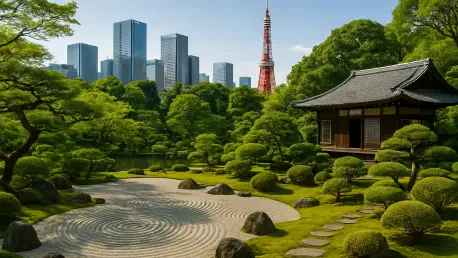In the heart of Tokyo, where towering skyscrapers and ceaseless crowds define daily life, a staggering 80% of residents report feeling overwhelmed by urban stress, according to recent studies on city living, and amid this chaos, a serene escape awaits in the form of meticulously designed gardens. These spaces offer not just greenery but a profound sense of peace. Guided by the wisdom of Shunmyo Masuno, a revered Soto Zen monk and acclaimed garden designer, this exploration reveals how these green sanctuaries serve as vital retreats, blending ancient philosophy with modern needs. Prepare to step into spaces where time slows, and the mind finds clarity, as Masuno’s insights unveil the transformative power hidden within Tokyo’s most iconic gardens.
The Vital Role of Green Havens in an Urban Jungle
Tokyo, with its relentless pace and dense population, often leaves little room for quiet reflection. Yet, the city’s historic gardens, many originating from the Edo period over 300 years ago, stand as enduring counterpoints to this frenzy. These spaces, once exclusive to feudal lords, now welcome all, providing a rare opportunity to disconnect from digital overload and reconnect with nature. Masuno, also the chief priest of Kenko-ji temple, emphasizes their importance as more than mere parks—they are living embodiments of Zen principles, designed to foster mindfulness in a world that rarely pauses.
The significance of these gardens extends beyond aesthetics into mental well-being. Research from urban health studies indicates that spending just 20 minutes in natural settings can reduce stress hormones by up to 30%. For Tokyoites and visitors alike, this offers a tangible antidote to the pressures of city life. Through Masuno’s perspective, the gardens become not just places to visit, but essential tools for cultivating inner calm, reflecting a timeless need for balance in an ever-accelerating society.
A Zen-Inspired Tour of Tokyo’s Most Serene Gardens
Delving into Tokyo’s landscape, five extraordinary gardens stand out, each selected by Masuno for their unique ability to embody Zen ideals of simplicity and presence. Shinjuku Gyoen National Garden, sprawling across 144 acres, captivates with nearly 900 cherry trees of 70 varieties, creating an extended cherry blossom season each spring. Its alcohol-free policy ensures a peaceful atmosphere, ideal for families, while seasonal highlights like summer roses and winter daffodils maintain its allure year-round.
Rikugien Gardens, established in 1695, offers a poetic journey through autumn with 560 maples and ginkgo trees painting the landscape in vivid hues. Inspired by traditional waka poetry, its layout alternates between intimate, enclosed paths and expansive views, with nighttime illuminations adding an ethereal charm during fall foliage season. This garden serves as a reminder of nature’s fleeting beauty, encouraging visitors to savor the moment.
Hama-rikyu Gardens, positioned near Tokyo Bay, carries echoes of old Edo with its tidal pond and a 300-year-old pine, once a backdrop for shogunal duck hunts. Today, it provides a serene teahouse for reflection and hosts moon-viewing events in autumn, merging historical depth with tranquil appeal. Koishikawa Korakuen, dating back to 1629, impresses with its Edo-era design, featuring massive boulders and a pond mimicking Lake Biwa, while autumn light displays enhance its bridges and foliage. Lastly, Ninomaru Garden, nestled within the East Gardens of the Imperial Palace, offers a discreet haven in central Tokyo, with seasonal blooms providing quiet intimacy near imperial grounds. Each of these spaces invites a deeper engagement, reflecting Zen’s call to find stillness amid urban clamor.
Lessons from a Zen Master on Garden Appreciation
Shunmyo Masuno brings a rare depth to understanding these green spaces, drawing from his dual role as a monk and designer. “A garden is not something to analyze with logic, but to feel with the heart,” he advises, encouraging a shift from intellectual scrutiny to emotional connection. His teachings, rooted in Zen traditions that reached Japan over 800 years ago during the Kamakura period, highlight how minimalism in design can evoke profound tranquility, stripping away excess to reveal essence.
Masuno’s personal reflections add a layer of authenticity to his guidance. Recounting a moment of clarity while watching a single leaf drift in Rikugien Gardens, he illustrates how small, mindful observations can spark significant inner shifts. This perspective transforms a visit into a meditative practice, where the act of simply being present becomes a gateway to insight, aligning with Zen’s focus on direct experience over abstract thought.
His approach also challenges modern habits that often dilute such experiences. The constant urge to document every moment through smartphones, he notes, can disconnect visitors from the very serenity they seek. By advocating for unhurried exploration, Masuno’s wisdom serves as a bridge between ancient philosophy and contemporary life, offering a fresh lens through which to view these timeless spaces.
Practical Steps to Embrace Mindfulness in Tokyo’s Gardens
To fully absorb the essence of Tokyo’s gardens, Masuno provides actionable advice grounded in Zen philosophy. Start by arriving with clear intent, leaving behind the rush of daily life and the need to check off destinations. This initial pause sets a tone of openness, allowing for a deeper connection with the surroundings rather than a superficial glance.
Once inside, seek out a quiet corner to sit or walk slowly, resisting the pull of conversation or excessive photography. Focus instead on subtle details—the whisper of leaves or the shimmer of light on water—to anchor attention in the present. Limiting digital distractions is also key; keeping phones tucked away except for brief, intentional captures helps maintain immersion in the moment, avoiding the trap of virtual engagement over real experience.
Masuno further suggests revisiting the same garden across different seasons, noting how spring blossoms at Shinjuku Gyoen or autumn maples at Rikugien reveal nature’s cycles and personal growth. After each visit, taking time to reflect—whether through journaling or silent contemplation—on how perceptions evolve can uncover deeper self-awareness. These steps elevate a simple outing into a journey of mindfulness, transforming Tokyo’s gardens into spaces of personal renewal.
Reflecting on a Journey of Serenity
Looking back, the exploration of Tokyo’s gardens through Shunmyo Masuno’s Zen perspective proved to be a profound reminder of nature’s quiet power amid urban chaos. Each garden, with its distinct character and seasonal beauty, offered a unique window into mindfulness, guided by principles that have stood the test of centuries. The lessons learned—from setting aside distractions to embracing fleeting moments—reshaped the way these spaces were experienced, turning casual visits into meaningful encounters.
As a next step, consider planning a visit to one of these sanctuaries, whether Shinjuku Gyoen for its blossoms or Hama-rikyu for its historical echoes, and apply Masuno’s mindful approach to uncover personal insights. Beyond a single trip, think about integrating small practices of presence into daily routines, finding pockets of calm even in the busiest environments. These gardens teach that serenity is not just a destination but a skill to cultivate, one that can ripple into broader aspects of life with intentional effort.









